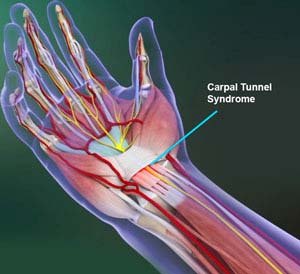Carpal Tunnel Syndrome

What is the Carpal Tunnel?
The carpal tunnel is a narrow passageway on the palm side of your wrist. Small wrist bones known as carpals form the bottom and sides of your carpal tunnel and a strong band of connecting tissue, known as the transverse carpal ligament, covers the top of the carpal tunnel. The carpal tunnel houses the flexor tendons, that allow you to bend your fingers, and the median nerve that provides sensation to most of your fingers and hand. Special tissues known as synovium surround and lubricate the flexor tendons in your wrist, allowing smooth movement of the fingers.
What is Carpal Tunnel Syndrome?
Carpal tunnel syndrome is a group of symptoms which include numbness, tingling, and pain that occur in your hand when the synovium swells, narrowing the limited space within the tunnel and pinches the median nerve over time. The transverse carpal ligament can also become tight, narrowing the carpal tunnel space and putting pressure on the median nerve.
Symptoms of Carpal Tunnel Syndrome
Some of the common symptoms associated with carpal tunnel syndrome include:
- Numbness and tingling in the thumb, index, and middle fingers
- Pain and burning in the hand and wrist that may radiate up the arm to the elbow
- Decreased sensation and weakness in the hand with diminished grip strength
- Worsening of symptoms at night
Risk Factors for Developing Carpal Tunnel Syndrome
The following factors have been known to increase a person’s risk of developing carpal tunnel syndrome:
- Repetitive Motion: Performing heavy, repetitive hand and wrist movements with prolonged gripping at work or play
- Congenital: Some people are born with narrower carpal tunnel canals.
- Trauma: Injury to the wrist such as fractures or sprains.
- Hormonal Changes: Pregnancy, menopause, birth control pills or hormone pills are risk factors as they alter the levels of hormone in the body.
- Medical Conditions: Conditions such as hypothyroidism, rheumatoid arthritis, diabetes, obesity, gout, overactive pituitary gland, or the presence of a cyst or tumor extending to the carpal tunnel
Diagnosis of Carpal Tunnel Syndrome
Your doctor diagnoses carpal tunnel syndrome by performing a detailed medical history and physical examination. Further tests may be ordered including an X-ray to view your wrist bones; blood tests to rule out underlying medical conditions such as diabetes, arthritis and thyroid problems, and electrodiagnostic testing to assess the speed and degree of electrical activity in your nerves and muscles.
Treatment for Carpal Tunnel Syndrome
Carpal tunnel syndrome can be treated with conservative measures or surgical intervention. Conservative treatment options may include hand and wrist immobilization with a splint or wrist brace for 4 to 6 weeks. Ice packs may be recommended to keep down any swelling. You may be advised to avoid activities that tend to bring on the symptoms. Medication and steroid injections may be used to treat pain and swelling. You may be referred to therapy to be taught strengthening and stretching exercises. When conservative treatment options are not effective, carpal tunnel release surgery may be recommended. Your doctor will discuss all the options with you and design an individualized treatment plan to treat carpal tunnel syndrome.
